More actions
No edit summary |
No edit summary |
||
| (83 intermediate revisions by 7 users not shown) | |||
| Line 1: | Line 1: | ||
{{Info religion | {{Info religion | ||
|image = | |image = Estelleyshield.png | ||
|pronunciation = | |pronunciation = Es-te-ley | ||
|origins = 15,000 years ago. | |origins = Presumed roughly 15,000 years ago. | ||
|deities = | |deities = Three greater Gods, 5 Gods, 5 optional Gods. | ||
|}} | |}} | ||
Estelley is the world's largest religion, due to its popularity among Elves. It is a moralizing religion that asks the worshiper to become the best version of themselves that they can be. Despite the long shadow it casts across history, Estelley has no explicit political or material demands. It concerns itself mostly with the kingdom of the heart, which only an individual can ever truly know. It proclaims the guidance of three Empress Goddesses, who founded the faith and wrote its holy books in antiquity, but has acquired many, many more over the ages. Though some Elven peoples have left it, Estelley is the for-Elves, by-Elves religion of Aloria, and will always remain so. | |||
Estelley is the | |||
==Origins== | ==Origins== | ||
Estelley | Estelley was founded in antiquity when three Elven Goddesses came together in sacred marriage. Relations with their [[Khama]] liege-lords, the Gods of the then-dominant Dewamenet Empire, deteriorated until war erupted. The Elves triumphed by the will of Magic, destroying the Dewamenet Empire and putting its [[Asha]] citizens to flight. This victory poised Estelley for world dominance, and though its war Goddess Talea soon fell to slumber and its art Goddess Sapphora fell to liquor, it has enjoyed that dominance until recent centuries. Now, it is threatened by upstart religions and foreign invasions threatening its holy places, and its future seems uncertain. | ||
==Core Beliefs== | |||
===Central Message=== | |||
The central message of Estelley is that the world is flawed, but the Gods have a plan that will lead mortals to create a better future. In this way, it is often compared to [[Unionism]], whose vision for a virtuous and united people makes it often considered Estelley's younger, stronger successor. However, there are key differences beneath the veneer. Unlike Unionism which centralizes under the Emperor, Estelley is completely individual. It has nothing to say about the organization of society, nation-hood, or state-hood, but quite a bit to say about how to be a good person--at least, by the Elven definition. For every Estellian who dies and goes to the afterlife, Merjan ("The Eternal" in Elven), the virtues that they achieved in life add onto a great scale measured against the sins of the mortal world. When Merjan is more perfect than the mortal world is flawed, the Estelley Gods will fling open the gates of the afterlife and reality will be remade, eternally graceful. | |||
== | ===The Afterlife=== | ||
Estelley | The Estelley afterlife, Merjan, is described as a physical realm at the end of a long river. After an unspecified amount of time sailing down the river on Ammuloa's barge, a dead worshiper arrives at a gray and rainy but beautiful land. In its center, the souls of bygone Elves live in the white-walled City of the Empresses on a large hill, perfectly circular and infinitely subdivided. Each successive generation, each successive soul, contributes by building another district in homage to the world that they experienced. They lack nothing and dwell in peace together, often going into slumber for centuries at a time, waiting for the day that the doors to the mortal world will swing open and time will cease to pass. The sinful, however, are denied Merjan. Offenders of the Gods, defilers, profaners, wicked abusers of Magic and mass murderers are judged by Artarel as failing, and imprisoned in a fever-dream of their life while sailing with Ammuloa, reliving their worst moments, unable to tell that it is an illusion. Only the remaking of the world can pardon them, when they will finally be forgiven and released back into the Gods' end reality. | ||
===The Walking Tales=== | |||
Estelley is the only religion with a large set of canon holy books, called the Walking Tales of the Empresses, or sometimes just the Tales for short. They are a series of passages from the point of view of Talea, Cemaan, and Sapphora taken down before or near the beginning of Allorn history. Time has seen many books warped, degraded, misinterpreted or destroyed, but with these three Goddesses returning to activity in the modern era, corrections have been issued and the modern Tales are considered reliable. Many of the passages seem like they were initially intended to be memorized, with question-answer formats typical to long poetry. Each one begins with a description of the Goddess it is about at the time of the Tale in question, then seeks to teach a lesson through a simple parable: either the conquest, coercion, or convincing of another God into the Estelley Pantheon, or an encounter with a mortal who seeks help with an issue and asks for advice. For an example Tale, see Expanded Lore. | |||
==Gods and Goddesses== | |||
Estelley has one unified Pantheon that is divided into sections. Beginning with only the Empresses, all the other Gods were inducted into the Pantheon individually with the passage of time, but cluster into groups based on association with one another. Each group predictably acts in one another's interests. All Estelley worshipers pay homage to all of the Gods. | |||
===The Empresses=== | |||
The Empresses are the founding Goddesses of the Estelley Religion. They are usually depicted as three estranged wives, with the sacred bond of the religion's formation as an analogy for marriage, and vice versa. Beforehand, they were all Goddesses of war, but specialized into their modern roles when they made a deal with each other. | |||
====Talea, Empress of War==== | |||
[[File:Brydef.png|left|frameless|250px]] | |||
Talea is the Estelley Goddess of conquest and martial prowess. It was by her hand that the Pantheon was united for the first time, and by her will that it acted together to defy the Dewamenet. She is often prayed to as 'Avenging Talea' when a worshiper wants strength to overcome their enemies, or to defend the Elven people from aggression, as she is the hero-Goddess who saved the Elves from destruction at the dawn of their history. Despite her warlike aspect, Talea is portrayed as quiet, somber, and poetic, a brooding woman cast from swords. She is worshiped through revenge, the spilling of enemy blood, and destruction of people who insult or hurt the Elves. | |||
Early in Allorn Imperial history, Talea was assailed by something only referred to as a 'force of darkness' and trapped in death-like sleep. This meant that despite her being the pantheon's founder, her Cult was eclipsed by Cemaan's, who remained active after her incapacitation. It has been fifteen millennia, making Talea a God that only existed on paper. Despite this, Talea's name was invoked every time the Allorn Empire invaded anything, which gave her a reputation that she perhaps did not earn. Eight short years ago, Talea was re-awakened in unclear circumstances. Since then, she has tried to retake her seat as the head of the Pantheon, but Cemaan will not cede her power. | |||
====Cemaan, Empress of Power==== | |||
[[File:Cemaani.png|left|frameless|250px]] | |||
Cemaan is the Estelley Goddess of power, lineage and strong rule. Through the tumult of the Allorn Empire's long history, which saw Gods defect, disappear, die or work against her, she maintained an iron-clad and increasingly bitter grip on power. She is prayed to for the insight to command, to put others to their best purposes. Cemaan is usually depicted in the company of her Golden Host, a mysterious terracotta legion of Eidolon Demons answerable only to her who have appeared at pivotal moments in history to tip the scale in favor of Estelley worshipers. | |||
Cemaan is clearly influenced by the Hollow. It is known that in the war with the Dewamenet Empire and their Khama Gods, she accepted a bargain with a Death God for the power to survive. In exchange, she killed the Khama Goddess Pahtia and almost killed her husband Khannar, who survived as an Undead through sheer rage and spite against her. Her Estelley followers, even, regard her with fear and worship her mostly through appeasement not to judge them as failing and revoke their free will to bend them to her command. That said, it is only through her cruel genius that Estelley survived the collapse of the Allorn Empire and crawled into reforms that saw it returned to good standing. Even the most resentful worshipers owe everything to her. | |||
====Sapphora, Empress of Love==== | |||
[[File:Saphori.png|left|frameless|250px]] | |||
Sapphora is the Estelley Goddess of love, but more importantly art, music, design, athletics, architecture, and everything enjoyable in civilization. She was originally a Goddess of war, too, but put down the spear when uniting with Talea and Cemaan. When the Dewamenet War ended and Talea was removed from the picture, Sapphora fell into a guilt-laden despair, and spent all following history as a drunken wastrel paying no heed to divine affairs. Just in the summer of last year, when her patron city was under threat, a few brave Elves collected her relics and broke into her place of residence to persuade her to stand idle no longer, making her an active force in the world again. | |||
Her aspect as a Goddess of love is comparatively new. The Walking Tales call her the Empress of Here and Now, because she is primarily worshiped by people who create things and wish them to be beautiful, not necessarily just to be beautiful themselves. All sorts of artisans, smiths, and painters place her icon in the corners of their shops. Even while a drunkard but especially now, she is the most active and sociable of the Estelley Gods who holds the Pantheon together at the top despite Cemaan and Talea's abrasiveness. She is just as powerful as either of them, even if non-Elves are frequently fooled by her gentle title into believing she is weak. | |||
===The Woodland Gods=== | |||
The Woodland Gods joined the Pantheon when a peace treaty was made between the early Allorn Elves and the Freefolk, who were at the time, besides the Suvial, the only other large Elven group. They warred until the Empresses sat down with the three Woodland Gods and made the so-called Three-by-Two Pact, binding them into an alliance but subordinating the latter into Estelley. | |||
====Gilan, The Forest King==== | |||
[[File:Gilanno.png|left|frameless|250px]] | |||
Gilan is the Forest King of the Auldwalds, mysterious and closed-off forests in which the Freefolk live under the protection of their Patron Gods. To the Estelley faith, Gilan is the God of the Hunt, and beast dominion, in that the faithful are lord and master over the lesser creatures of the world. Gilan teaches his followers to fear the unknown of the forest, and to respect the awesome and infinite power of nature, even if they seek to control parts of it. Gilan is a capricious God who is worshiped both as a means to protect against the monsters and beasts that reside in the forest, and also as a whip to punish the transgressors of his grove to learn humility and submission. | |||
Gilan holds a somewhat complex role, because inherent to Estelley beliefs is Allorn supremacy, and inherent to Allorn supremacy is the idea that his Auldwalds should become subject to the Allorn Empresses. Gilan in turn defends these forests from encroachment by the Elven princes, meaning that there can be situations in which the faithful are actively fighting their own God. Gilan will always hold particular favor for the Freefolk above all Estelley faithful and is more often than not fear-worshiped by other groups to avoid his wrath or punishment, by leaving offerings at the edge of the forests for the dwellers within. | |||
====Mana, Compassionate One==== | |||
[[File:Iiiiiiiiiiii.png|left|frameless|250px]] | |||
Mana is the Estelley Goddess of the natural world and kindness, taken together. She cultivates the groves, the plants and the beauties of the world that the worshipers adore, but she also teaches them to love one another and be better to strangers. She is considered the patron mother of the [[Yanar]] people, and by far the sweetest of the Estelley Gods. The chaotic fall of the Allorn Empire and the burning of many of her groves by the enemies of the faith has left her in a drastically weakened state, but she still appears to regularly tend to the faithful in any way she may. | |||
She is supposed to be a personal friend of Sapphora, but dismayed by her turning to drink to drown her guilt. Therefore, those who hold Mana in high esteem can sometimes abstain from drink for religious reasons, or encourage others to do the same. Those who see Mana as their patron are frequently healers, counselors, and others who try to embody the kindness that she puts into the world. The oath of no harm that Elven medics sometimes take is done in Mana's name. Mana Trees, the symbol of Estelley communities, are simply large oaks enhanced with Magic and named after her, since she is a byword for cooperation. In times of trouble, Mana is also prayed to to make the end of crisis come easily. | |||
====Soma, Goddess of Logic==== | |||
[[File:Dddddddulleyinthaolis.png|left|frameless|250px]] | |||
Soma is the Elven Goddess of logic, reasoned thought, and pre-planning. Because of this, she is considered to have some domain over time itself. Depicted as a cave-horror of the deep caverns far, far below Daen, she is the patron of the Erythar [[Freefolk]], who make their home in ravines and crevices in her image. As a schemer, the long reach of her arm is visible on many little choices made to ensure the survival of the Estelley religion through hard times, even subtly against the momentary wishes of other Estelley Gods far more bold and brash than her. | |||
Oftentimes, Soma is the patron of people in very planning-heavy fields, like mathematics, logistics, and the higher sciences. She is prayed to for the ability see through messy situations with clarity and make the right decision, or for the mental acumen to crack the impossible puzzle. Since she is a Goddess of contingency in her own right, her more deep-pocketed or sharp-sworded followers also frequently become hoarders of historical relics, paintings, and Artifacts of Magical or non-Magical nature, just because they might need them someday. Vaults, larders, and other storage places are usually blessed with her icon to ensure that nothing gets lost either to thieves or time under her watchful eye. | |||
===The Inner Gods=== | |||
The Inner Gods joined the Pantheon individually in the early parts of Allorn history. Usually, each of them was the patron of a distinct Elven or non-Elven tribe, which was crushed, coerced, or persuaded into the Allorn Empire, and then their divinities integrated into its growing Pantheon. Any tribes described do not exist anymore, and have not for 10,000 or more years. They exist only in historical reference. | |||
====Aseia, God of Magic Knowing==== | |||
[[File:Aisheiah.png|left|frameless|250px]] | |||
Aseia is the Estelley God of Magic, but more specifically knowledge of Magic. They do not explicitly demand that the worshiper becomes a Mage, though becoming a good Mage is incredibly virtuous in their eyes. It is far more important to them that Estelley worshipers are not ignorant to the workings of Magic, or of Magic creatures like Demons, so that they are not outsmarted and beaten. Before they were part of the Estelley Pantheon, they were the patron of an Elven people called the Avalli, who Cemaan coerced into dependency on the Allorn Empire and then absorbed, assimilating them into the whole. In the modern day, they assist the Goddess of law Artarel with her lists of codes and crimes. | |||
Across the academies of the Elven world, Aseia is invoked for skill with the study of Magic and protection from the risk of failure. Perhaps surprisingly, they have a very good relationship with Talea, and the Tales often depict them as her faithful friend and the only one who knows how to calm her down from a rage with their impersonal, blunt commentary, as well as the only one brave enough to tell her when she is wrong about something out of sheer social unawareness. They are famously verbose and slow to get to the point, but always well-intentioned. | |||
====Ammuloa, God of the Death Kiss==== | |||
[[File:Ammuloa.png|left|frameless|250px]] | |||
Ammuloa is the Estelley God of death and the dying. Before he joined the Estelley Pantheon, he was the patron God of nomadic Elven river tribesmen called the Loallë, who were violently conquered by Talea. It is known that he is rather fond of Cemaan, due to the fact that she inflicts much of the death which he must notate and clean up after, and they often see one another in the process of her doing so. Those who would claim Ammuloa as their patron are usually soldiers who obey his message to both face and deal death with dignity, to never deny the one they slay just burial and just afterlife, and to refrain from the cruelty of corrosive Curses and Magic when they go in for the kill. | |||
Little icons of his hooded figure are often propped up in the corner of soldiers' chapter-houses. It is considered bad luck to depict him, though when he is it is with an insectoid form as pictured. It is equally considered bad luck to say his name when outside a place of death like cemeteries, especially in hospitals or healing houses, since inviting his attention drags the long reach of the underworld a little closer to the worshiper. Despite this, like the death Gods of most religions, Ammuloa is considered a calm, even kind figure. When a dead faithful sails down the river to the afterlife on his barge, it is him who keeps them company and comforts them. | |||
====Leyon, God of Farsight==== | |||
[[File:Sdafafafafas.png|left|frameless|250px]] | |||
Leyon is the Estelley God of wisdom and good counsel. It is not understood when, why, or where Leyon found his way into the Estelley Pantheon, only that he mysteriously appeared and claimed a place. Talea thought that Cemaan had invited him, while Cemaan thought that Sapphora had invited him, and Sapphora thought that Talea had invited him. Leyon never speaks: he only rattles in rustling wind-chimes that the listener understands in the form of visions. He has something of a fearsome reputation among the Fae, the Demons of the Anima, and they consider him the one entity in the world that they are not willing to trifle with. As a result, he sometimes protects or saves Elves lost in the Anima. He is considered a good friend of the law Goddess Artarel, whose Godborn he shapes into existence. | |||
In Estelley's most troubled hours, Leyon was often asked for his wisdom instead of the aggressive Cemaan. When none of them can agree, it is him who is invited to settle the dispute and make things right. His worship and patronage are somewhat complicated, because Soma already holds the domain of foresight and planning, while Cemaan holds the domain of command. To please Leyon is specifically to lead in a way that benefits and uplifts the lives of others, and to make sure that civilization works not just for you, but for them. He believes in no worshiper left behind, no friend scorned, no corruption permitted. | |||
====Sinnavei, Goddess of Dignity==== | |||
[[File:Sinavaallano.png|left|frameless|250px]] | |||
Sinnavei is the Estelley Goddess of dignity, and the patron of the [[Solvaan]] people. Before she was a member of the Estelley Pantheon, she was the patron of an Elven hill tribe called the Elari, who lived on cliffs facing the sea until Sapphora persuaded them to come and dwell in the lands below. It is well understood that she has a forbidden romance with the [[Evolism|Evolist]] Demon God Morrlond, the cruel conqueror of the oceans, and that the Estelley sea Goddess who competes with him, Vyrë, does not like her because of it. After her absorption she followed the Elven colonists across the ocean who would later become the Solvaan, and adopted them as her own, appearing like one of them. | |||
Sinnavei asks that every mortal worshiper faces the challenges of living with grace, reverence, and respect, never to betray the oaths they form, and never to falter because a promise was too dangerous. She demands that friends and allies are given dignity in wrongdoing, and enemies not mistreated beyond what is right for what they have done. She is also a symbol of Elven pro-Regalian sentiment, since at the Empire's founding she gave the signal that the Solvaan should assist, and has always exhibited pro-Unionist lip service when inquired by mortals. Sailors who wish to keep Morrlond's furious gaze away also pray to her as an intercessor. | |||
====Vyrë, Goddess of the Seas==== | |||
[[File:Vyregoddes.png|left|frameless|250px]] | |||
Vyrë is the Estelley Goddess of the vast oceans and the unknown. She is immensely powerful, and the patron of the Finul culture of Elves, called an Empress by them half-jokingly in the belief that she could compete with any of the three, but merely chooses not to out of respect for their domain. In history, she fought several legendary stalemate battles with Talea, but while never subjugated was impressed by her bravery and agreed to swear fealty to her Pantheon as an equal. Vyrë asks that worshipers work together to survive the unknown that she represents, and never to falter from authority in the face of fear. | |||
While Morrlond is fear-appeased to keep him away, sailors and especially Finul pray to Vyrë to make them glorious for her, to give them victory on the open ocean over the enemies of Elvenkind so that they can make an offering of the fallen blood to her domain. They believe that it was her who gave them their biological ability to breathe underwater, who kissed them with her touch so that they could do great deeds in her name. There is a tradition of pouring the first drink at any seafood dinner into the fire as a gift to Vyrë, to thank her for the sea's bounty. | |||
===The Outer Gods=== | |||
The Outer Gods joined the Pantheon individually in the later parts of Allorn history. This was either through their subject people drifting closer to the Allorn sphere, by being outside entities that were invited, or because their previous subjects were destroyed by outside forces. | |||
====Artarel, Goddess of Just Law==== | |||
[[File:Artareill.png|left|frameless|250px]] | |||
Artarel is the Estelley Goddess of justice and law, a refraction of the Justice Arken. This means that she shares a set of memories with this powerful Demon, but they do not have the same beliefs or same actions, even if all awareness is shared evenly between them. The exact timeline of her manifestation into the Estelley Pantheon is unclear, because she arose as a product of mass heretical Arken Worship for Justice to deliver Elves from pain and tyranny, resulting in Artarel's divine form arising. The last gasp of any uncertainty was a few years ago, when a mass death incident caused by the [[Khama]] God Tjafar's rebirth made her play her hand openly. | |||
Artarel demands that the worshiper is fair, honest, and even-handed, and that they hold even other Estellians accountable for their wickedness when they forget themselves and step out of line. She is a widely regarded hero-Goddess with an heirloom claymore sword called Nightfall or Maan-Menvaan, who has appeared at pivotal points in history to slay Demons, alone or in conjunction with her Arken alter ego. Artarel is responsible for a law code named after her, Artarel Law, which is the basis of all Elven Law. Its concepts include trial by jury and equality under the law, but if applied with an inflexible eye quickly become draconian. | |||
====Avinla, Goddess of Living Fire==== | |||
[[File:Avinloo.png|left|frameless|250px]] | |||
Avinla is the Estelley Goddess of family, community and warmth, and the patron of the [[Suvial]] people. A proud, independent Elven kingdom, the Suvial refused to join the Allorn Empire, and with their mastery of Demons resisted for thousands of years until finally being forced to bend the knee around a thousand years ago. With them, their Goddess Avinla finally joined the Estelley Pantheon. She is known to have been good friends with the [[Draconism#Armina,_the_Community_Dragon|Dragon Armina]], who the Suvial held in duo-worship with her until they were converted into Estelley, and sometimes syncretize back into Draconism to retain. Avinla asks that the worshiper be inclusive, and treat their relatives and friends well, to always make sure there is a warm spot by the hearth for even the disgraced to return to. | |||
When the Suvial became the target of Kathar mass death spells called Void-Outs in the war between them, around a hundred fifty years ago, Avinla sacrificed and petrified herself to prevent them from becoming the target of any more. With Armina disappearing around the same time, the Suvial are left without answers, and with a forced immortality that they see as a curse instead of a blessing. It is the goal of many Suvial faithful to resolve what happened to Avinla and how to bring her back, while also making sure that they will not immediately become a target again. | |||
====Melca, Goddess of All Wealth==== | |||
[[File:Sihndargod.png|left|frameless|250px]] | |||
Melca is the Estelley Goddess of all wealth, not just monetary, but also in diplomacy, allies, and true friendship from outsiders. She was once called Marxxarana, and was the duo-Goddess of a non-Elven people called the Drovv with her husband Morxxeron, a now-[[Dead_Gods#Morxxeron,_Star_Warden_of_the_Drovv|Dead God]]. When Cataclysm came three hundred years ago and Demons invaded the world, both the Drovv and Morxxeron were killed containing them, and the Elven survivors from nearby regions changed into the Sihndar. These survivors would worship the now widowed Melca, and petition Cemaan for her induction into the Pantheon, which she granted. | |||
That Melca is a Goddess of wealth despite the Sihndar being some of the poorest people in Aloria, who live in the most miserable conditions, is seen by outsiders as an ironic consequence of her weakness. However, the Sihndar maintain a vast diplomatic network around the world and have every ear in every civilized society, squeezing out every single coin they can for the defense of their home Drowda against the endless Demons that assail it. In a kinder world, Melca would be a Goddess of coin and comfort, but her devoted Sihndar worship her because without the skill that she endears they would all die alone. | |||
====Suellon, God of Forever Change==== | |||
[[File:Magnificentmaster.png|left|frameless|250px]] | |||
Suellon is the only Estelley God who was once a mortal man, a Teled named Suel whose life is well documented. He was a Prince with an extensive domain in central Daen, who was contracted by the Empress of the time, Vinnalea, to engineer the ultimate soldier. He experimented with Genos, the ability to alter life, until stumbling into the creation of the people who would later become the [[Maquixtl]]. Instead of giving his followers to Vinnalea to fight her wars, he betrayed her and started a large-scale insurrection instead. | |||
When Cataclysm came, he, his spouses, and most of his followers left Daen behind and crossed the ocean to the western continent of Guldar, settling in the ruins of the dead Avarr civilization. Suellon divinely ascended by absorbing one of their Gods in unclear circumstances and making many deals with Dragons, as the now-dead Dragon Caius used to live in Guldar. After this, he smugly petitioned Cemaan to give him the chair he felt he deserved for his master ploys, which she begrudgingly accepted to claim dominion over some of the Maquixtl rather than lose then all to Draconism. Suellon tells the worshiper to be a little trickster and take advantage of even bad situations, because chaos hides opportunity for the willful. | |||
== | ==Expanded Lore== | ||
Estelley | ===Priesthood=== | ||
An Estelley priest is called an Ordvaan, which means Guide. It is the responsibility of an Ordvaan to preach and know all the Gods. While before Cataclysm, individual teachings were decentralized, nowadays Ordvaan are answerable to something called the Presenna Council, a large conclave of Estelley priests in the Presenna Principality who rule on religious law. In places where the majority population is hostile to an Estelley minority, Ordvaan become community leaders, and in places where Magic is imperiled or outlawed, they also serve as Magic teachers. Because of the late Allorn aristocracy's large-scale corruption and deviation from Estelley virtue, many Estellians let them take this community-leader role. Estelley priests usually do not try to convert Ailor, but do try to convert Elves from the non-Estelley populations if they think they stand a chance of it working. Ordvaan can come from any Estelley cultural interpretation, like Freefolk, Teled, or Sihndar, all of whom share the same role and respect. | |||
===Historical Nuance=== | |||
Over its fifteen millennia of existence, Estelley has seen turmoil and upheaval. Three hundred years ago, when the Allorn Empire was destroyed in magical calamity, it underwent a vast reform. This brought together the Gods who had drifted apart and re-formalized the religion, which at that point was in serious danger of falling apart. It is important to understand that Estelley as worshiped now is very different from Estelley as worshiped a thousand years ago, when the Allorn Empire was in free-fall decline and wracked by wars between God-like, completely unaccountable Archmages. Many of its virtues had lain forgotten, its tenets abused for violence and cruel conquest, both on other Elves and on people outside the Empire. Modern Estellians must often reckon with other faithful's historical mistrust over things that happened a very long time ago, and navigate delicately how to make it up without kneeling too low for their own tastes. | |||
== | ===Historical Conflicts=== | ||
Estelley | Estelley has a long history, which contains conflicts that a learned worshiper would know about. | ||
* '''Khama:''' At the beginning of history, the Elves revolted against the Khama Gods and their Dewamenet Empire oppressors, crushing them completely and chasing their subjects the [[Asha]] to the ends of the known world with great violence and [[Asha#The_Pearl_Wars|soul-destroying magic]]. Cemaan killed one Khama Goddess, Pahtia, and almost killed another, her husband Khannar. The Asha do not forget, and throughout history and the modern day, are the most reliable and dedicated opponents of the Estelley religion by any means necessary. Yet, there are also whispers that the [[Dead_Gods#Pahtia,_Dreaming_Goddess_of_Art|Dead Goddess Pahtia]] can be saved, and the old wound healed over. | |||
* '''Draconism:''' In the late Allorn Empire, a Prince named Varendracar converted to Draconism and tried to unseat his cousin, the Empress. While Estelley doesn't specifically bless the Allorn Empire, and many Allorn atrocities are a stain on Estellians' conscience, if Varendracar won he would have dismantled Estelley as the state religion. That led to a violent reprisal that saw many Draconists murdered, even after he lost. That, and the fact that a Dragon was killed by Allorn forces (technically two, by consequences of the war), means that specifically [[Isldar]] Elves, his followers' descendants, usually have a bone to pick with Estelley. | |||
* '''Evolism and Void Arken:''' The Dark Gods of Evolism and the Void Arken (especially Pride) played a role in ensuring the collapse of the Allorn Empire by subverting Estelley Worship and giving Elves more magical power than they knew what to do with. While the Void Arken are styled as seductive wickedness, or the idols of barbarians since the Vola [[Fornoss]] Pantheon is Void Arken and worshiped by rugged Ailor who Allorn Elves fought many wars with, the Evolist Gods are declared the ultimate evil to end all evil, and their worshipers the enemies to the death of all virtuous men. | |||
===Va'sil & Mana Trees=== | ===Va'sil & Mana Trees=== | ||
The Va'sil were holy | The Va'sil were holy nature spirits who took the form of giant, walking trees. They were holy advisors for much of Allorn history, reportedly wise, and gentle. Throughout the Allorn Empire's collapse and the decline of Estelley worship, the Va'sil and their groves became neglected. This would come to a head when the forerunners of the Kathar Heritage destroyed them in a single coordinated attack, the Night of the Fallen Star, which wiped every Va'sil tree from the world. Mana Trees, the ancient oaks at the center of Elven groves and places of worship, do still enjoy a holy status in reminiscence of the destroyed Va'sil. Yet much like the Va'sil before them, they are a target for attacks from Kathar looking to please their Gods through historical re-enactment. | ||
===Example Walking Tale=== | |||
This is an example Walking Tale about the Goddess Sapphora, in case you would like to produce more scripture. | |||
<div class="mainpage_box"> | |||
Lady Sapphora is tall and broad, clad in golden raiment and with eyes joyful as the sun. | |||
Our Lady came down from the mountain Fyror, and found thereupon a shepherd. | |||
He raised his crook in salute, and laid its base upon the ground, and regarded the Lady. | |||
"Oh, Empress of Here and Now, whose Desires are manifold and occupy all things, | |||
my neighbour has said that my staff is ugly, and that this diminishes me in the eyes of men." | |||
Replied the Empress of Here and Now, whose Desires are manifold and occupy all things, | |||
"Was it a staff made by the work of your own hands, which hewed and shaped the wood? | |||
Was this artifice cut from the oaken bough by an axe which you had wielded, striking?" | |||
Replied the shepherd, regarding his artifice of gnarled, pitted oak from an elder branch, | |||
"It was I who hewed and shaped this wood, and made this staff by the work of my own hands." | |||
Sapphora considered, and her pale brow knit in consideration of these worldly affairs. | |||
"Your neighbour is jealous, for he could not shape as you have shaped. Consider: | |||
Is it the domain of worthy men to be jealous of another? I say not, for were they worthy, | |||
They might surpass them in artifice, and render the bounty of their labour as a gift. | |||
Greatness falls in the grace of magnanimity, not in the abstract superiority alone." | |||
Wondered, the shepherd bowed his head and took a knee in front of his flock, facing the Empress. | |||
"I understand why the Empress of Here and Now is called the Empress of Here and Now, | |||
For in the present only is graciousness found to create the work of a better future, | |||
Which though flawed and scarred in its ways by the past as is my branch of oak roughly cut, | |||
Will like it, last through the ages as the work of no other hands but mine." | |||
</div> | |||
==Trivia== | ==Trivia== | ||
* | * Estelley worship is frequently denoted with moon symbolism, which is the heraldic icon of most Elven kingdoms. | ||
* | * Talea and her arch-rival Tjafar from [[Khama]] worship are very similar: Emperor-Gods often eclipsed by their younger partner. | ||
* | * The Estelley Gods' holy artifacts and tomes are scattered around the world. Not all of them have been reunited with their lost trinkets. | ||
{{Religion}} | {{Religion}} | ||
{{Accreditation | {{Accreditation | ||
|Artists = MonMarty | |Artists = MonMarty | ||
|Writers = | |Writers = OkaDoka, HydraLana, bahmboozled | ||
|Processors = | |Processors = FireFan96, MantaRey | ||
}} | }} | ||
[[category:Religion]] | [[category:Religion]] | ||
Latest revision as of 03:52, 7 April 2025
| Estelley | |
|---|---|
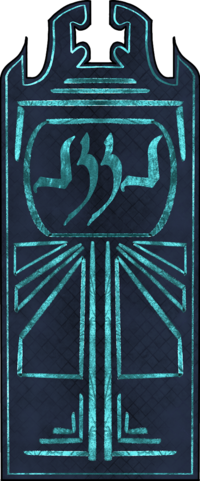 | |
| Religion | |
| Pronunciation | Es-te-ley |
| Origins | Presumed roughly 15,000 years ago. |
| Deities | |
| Three greater Gods, 5 Gods, 5 optional Gods. | |
Estelley is the world's largest religion, due to its popularity among Elves. It is a moralizing religion that asks the worshiper to become the best version of themselves that they can be. Despite the long shadow it casts across history, Estelley has no explicit political or material demands. It concerns itself mostly with the kingdom of the heart, which only an individual can ever truly know. It proclaims the guidance of three Empress Goddesses, who founded the faith and wrote its holy books in antiquity, but has acquired many, many more over the ages. Though some Elven peoples have left it, Estelley is the for-Elves, by-Elves religion of Aloria, and will always remain so.
Origins
Estelley was founded in antiquity when three Elven Goddesses came together in sacred marriage. Relations with their Khama liege-lords, the Gods of the then-dominant Dewamenet Empire, deteriorated until war erupted. The Elves triumphed by the will of Magic, destroying the Dewamenet Empire and putting its Asha citizens to flight. This victory poised Estelley for world dominance, and though its war Goddess Talea soon fell to slumber and its art Goddess Sapphora fell to liquor, it has enjoyed that dominance until recent centuries. Now, it is threatened by upstart religions and foreign invasions threatening its holy places, and its future seems uncertain.
Core Beliefs
Central Message
The central message of Estelley is that the world is flawed, but the Gods have a plan that will lead mortals to create a better future. In this way, it is often compared to Unionism, whose vision for a virtuous and united people makes it often considered Estelley's younger, stronger successor. However, there are key differences beneath the veneer. Unlike Unionism which centralizes under the Emperor, Estelley is completely individual. It has nothing to say about the organization of society, nation-hood, or state-hood, but quite a bit to say about how to be a good person--at least, by the Elven definition. For every Estellian who dies and goes to the afterlife, Merjan ("The Eternal" in Elven), the virtues that they achieved in life add onto a great scale measured against the sins of the mortal world. When Merjan is more perfect than the mortal world is flawed, the Estelley Gods will fling open the gates of the afterlife and reality will be remade, eternally graceful.
The Afterlife
The Estelley afterlife, Merjan, is described as a physical realm at the end of a long river. After an unspecified amount of time sailing down the river on Ammuloa's barge, a dead worshiper arrives at a gray and rainy but beautiful land. In its center, the souls of bygone Elves live in the white-walled City of the Empresses on a large hill, perfectly circular and infinitely subdivided. Each successive generation, each successive soul, contributes by building another district in homage to the world that they experienced. They lack nothing and dwell in peace together, often going into slumber for centuries at a time, waiting for the day that the doors to the mortal world will swing open and time will cease to pass. The sinful, however, are denied Merjan. Offenders of the Gods, defilers, profaners, wicked abusers of Magic and mass murderers are judged by Artarel as failing, and imprisoned in a fever-dream of their life while sailing with Ammuloa, reliving their worst moments, unable to tell that it is an illusion. Only the remaking of the world can pardon them, when they will finally be forgiven and released back into the Gods' end reality.
The Walking Tales
Estelley is the only religion with a large set of canon holy books, called the Walking Tales of the Empresses, or sometimes just the Tales for short. They are a series of passages from the point of view of Talea, Cemaan, and Sapphora taken down before or near the beginning of Allorn history. Time has seen many books warped, degraded, misinterpreted or destroyed, but with these three Goddesses returning to activity in the modern era, corrections have been issued and the modern Tales are considered reliable. Many of the passages seem like they were initially intended to be memorized, with question-answer formats typical to long poetry. Each one begins with a description of the Goddess it is about at the time of the Tale in question, then seeks to teach a lesson through a simple parable: either the conquest, coercion, or convincing of another God into the Estelley Pantheon, or an encounter with a mortal who seeks help with an issue and asks for advice. For an example Tale, see Expanded Lore.
Gods and Goddesses
Estelley has one unified Pantheon that is divided into sections. Beginning with only the Empresses, all the other Gods were inducted into the Pantheon individually with the passage of time, but cluster into groups based on association with one another. Each group predictably acts in one another's interests. All Estelley worshipers pay homage to all of the Gods.
The Empresses
The Empresses are the founding Goddesses of the Estelley Religion. They are usually depicted as three estranged wives, with the sacred bond of the religion's formation as an analogy for marriage, and vice versa. Beforehand, they were all Goddesses of war, but specialized into their modern roles when they made a deal with each other.
Talea, Empress of War
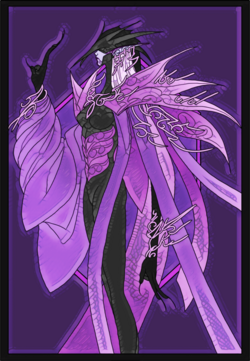
Talea is the Estelley Goddess of conquest and martial prowess. It was by her hand that the Pantheon was united for the first time, and by her will that it acted together to defy the Dewamenet. She is often prayed to as 'Avenging Talea' when a worshiper wants strength to overcome their enemies, or to defend the Elven people from aggression, as she is the hero-Goddess who saved the Elves from destruction at the dawn of their history. Despite her warlike aspect, Talea is portrayed as quiet, somber, and poetic, a brooding woman cast from swords. She is worshiped through revenge, the spilling of enemy blood, and destruction of people who insult or hurt the Elves.
Early in Allorn Imperial history, Talea was assailed by something only referred to as a 'force of darkness' and trapped in death-like sleep. This meant that despite her being the pantheon's founder, her Cult was eclipsed by Cemaan's, who remained active after her incapacitation. It has been fifteen millennia, making Talea a God that only existed on paper. Despite this, Talea's name was invoked every time the Allorn Empire invaded anything, which gave her a reputation that she perhaps did not earn. Eight short years ago, Talea was re-awakened in unclear circumstances. Since then, she has tried to retake her seat as the head of the Pantheon, but Cemaan will not cede her power.
Cemaan, Empress of Power
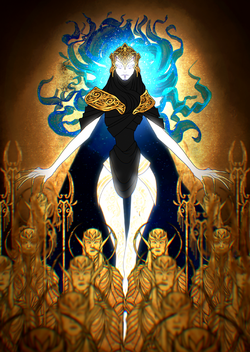
Cemaan is the Estelley Goddess of power, lineage and strong rule. Through the tumult of the Allorn Empire's long history, which saw Gods defect, disappear, die or work against her, she maintained an iron-clad and increasingly bitter grip on power. She is prayed to for the insight to command, to put others to their best purposes. Cemaan is usually depicted in the company of her Golden Host, a mysterious terracotta legion of Eidolon Demons answerable only to her who have appeared at pivotal moments in history to tip the scale in favor of Estelley worshipers.
Cemaan is clearly influenced by the Hollow. It is known that in the war with the Dewamenet Empire and their Khama Gods, she accepted a bargain with a Death God for the power to survive. In exchange, she killed the Khama Goddess Pahtia and almost killed her husband Khannar, who survived as an Undead through sheer rage and spite against her. Her Estelley followers, even, regard her with fear and worship her mostly through appeasement not to judge them as failing and revoke their free will to bend them to her command. That said, it is only through her cruel genius that Estelley survived the collapse of the Allorn Empire and crawled into reforms that saw it returned to good standing. Even the most resentful worshipers owe everything to her.
Sapphora, Empress of Love

Sapphora is the Estelley Goddess of love, but more importantly art, music, design, athletics, architecture, and everything enjoyable in civilization. She was originally a Goddess of war, too, but put down the spear when uniting with Talea and Cemaan. When the Dewamenet War ended and Talea was removed from the picture, Sapphora fell into a guilt-laden despair, and spent all following history as a drunken wastrel paying no heed to divine affairs. Just in the summer of last year, when her patron city was under threat, a few brave Elves collected her relics and broke into her place of residence to persuade her to stand idle no longer, making her an active force in the world again.
Her aspect as a Goddess of love is comparatively new. The Walking Tales call her the Empress of Here and Now, because she is primarily worshiped by people who create things and wish them to be beautiful, not necessarily just to be beautiful themselves. All sorts of artisans, smiths, and painters place her icon in the corners of their shops. Even while a drunkard but especially now, she is the most active and sociable of the Estelley Gods who holds the Pantheon together at the top despite Cemaan and Talea's abrasiveness. She is just as powerful as either of them, even if non-Elves are frequently fooled by her gentle title into believing she is weak.
The Woodland Gods
The Woodland Gods joined the Pantheon when a peace treaty was made between the early Allorn Elves and the Freefolk, who were at the time, besides the Suvial, the only other large Elven group. They warred until the Empresses sat down with the three Woodland Gods and made the so-called Three-by-Two Pact, binding them into an alliance but subordinating the latter into Estelley.
Gilan, The Forest King
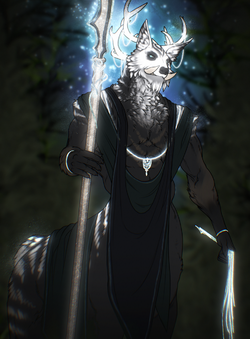
Gilan is the Forest King of the Auldwalds, mysterious and closed-off forests in which the Freefolk live under the protection of their Patron Gods. To the Estelley faith, Gilan is the God of the Hunt, and beast dominion, in that the faithful are lord and master over the lesser creatures of the world. Gilan teaches his followers to fear the unknown of the forest, and to respect the awesome and infinite power of nature, even if they seek to control parts of it. Gilan is a capricious God who is worshiped both as a means to protect against the monsters and beasts that reside in the forest, and also as a whip to punish the transgressors of his grove to learn humility and submission.
Gilan holds a somewhat complex role, because inherent to Estelley beliefs is Allorn supremacy, and inherent to Allorn supremacy is the idea that his Auldwalds should become subject to the Allorn Empresses. Gilan in turn defends these forests from encroachment by the Elven princes, meaning that there can be situations in which the faithful are actively fighting their own God. Gilan will always hold particular favor for the Freefolk above all Estelley faithful and is more often than not fear-worshiped by other groups to avoid his wrath or punishment, by leaving offerings at the edge of the forests for the dwellers within.
Mana, Compassionate One
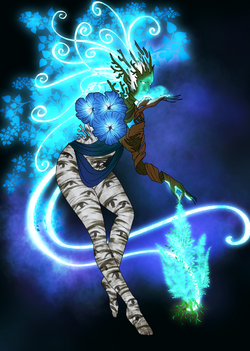
Mana is the Estelley Goddess of the natural world and kindness, taken together. She cultivates the groves, the plants and the beauties of the world that the worshipers adore, but she also teaches them to love one another and be better to strangers. She is considered the patron mother of the Yanar people, and by far the sweetest of the Estelley Gods. The chaotic fall of the Allorn Empire and the burning of many of her groves by the enemies of the faith has left her in a drastically weakened state, but she still appears to regularly tend to the faithful in any way she may.
She is supposed to be a personal friend of Sapphora, but dismayed by her turning to drink to drown her guilt. Therefore, those who hold Mana in high esteem can sometimes abstain from drink for religious reasons, or encourage others to do the same. Those who see Mana as their patron are frequently healers, counselors, and others who try to embody the kindness that she puts into the world. The oath of no harm that Elven medics sometimes take is done in Mana's name. Mana Trees, the symbol of Estelley communities, are simply large oaks enhanced with Magic and named after her, since she is a byword for cooperation. In times of trouble, Mana is also prayed to to make the end of crisis come easily.
Soma, Goddess of Logic
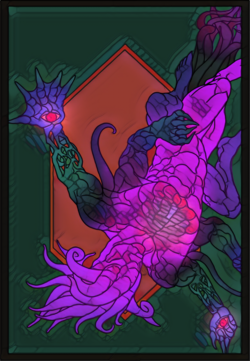
Soma is the Elven Goddess of logic, reasoned thought, and pre-planning. Because of this, she is considered to have some domain over time itself. Depicted as a cave-horror of the deep caverns far, far below Daen, she is the patron of the Erythar Freefolk, who make their home in ravines and crevices in her image. As a schemer, the long reach of her arm is visible on many little choices made to ensure the survival of the Estelley religion through hard times, even subtly against the momentary wishes of other Estelley Gods far more bold and brash than her.
Oftentimes, Soma is the patron of people in very planning-heavy fields, like mathematics, logistics, and the higher sciences. She is prayed to for the ability see through messy situations with clarity and make the right decision, or for the mental acumen to crack the impossible puzzle. Since she is a Goddess of contingency in her own right, her more deep-pocketed or sharp-sworded followers also frequently become hoarders of historical relics, paintings, and Artifacts of Magical or non-Magical nature, just because they might need them someday. Vaults, larders, and other storage places are usually blessed with her icon to ensure that nothing gets lost either to thieves or time under her watchful eye.
The Inner Gods
The Inner Gods joined the Pantheon individually in the early parts of Allorn history. Usually, each of them was the patron of a distinct Elven or non-Elven tribe, which was crushed, coerced, or persuaded into the Allorn Empire, and then their divinities integrated into its growing Pantheon. Any tribes described do not exist anymore, and have not for 10,000 or more years. They exist only in historical reference.
Aseia, God of Magic Knowing
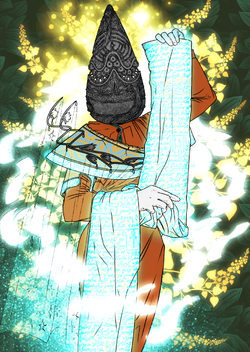
Aseia is the Estelley God of Magic, but more specifically knowledge of Magic. They do not explicitly demand that the worshiper becomes a Mage, though becoming a good Mage is incredibly virtuous in their eyes. It is far more important to them that Estelley worshipers are not ignorant to the workings of Magic, or of Magic creatures like Demons, so that they are not outsmarted and beaten. Before they were part of the Estelley Pantheon, they were the patron of an Elven people called the Avalli, who Cemaan coerced into dependency on the Allorn Empire and then absorbed, assimilating them into the whole. In the modern day, they assist the Goddess of law Artarel with her lists of codes and crimes.
Across the academies of the Elven world, Aseia is invoked for skill with the study of Magic and protection from the risk of failure. Perhaps surprisingly, they have a very good relationship with Talea, and the Tales often depict them as her faithful friend and the only one who knows how to calm her down from a rage with their impersonal, blunt commentary, as well as the only one brave enough to tell her when she is wrong about something out of sheer social unawareness. They are famously verbose and slow to get to the point, but always well-intentioned.
Ammuloa, God of the Death Kiss
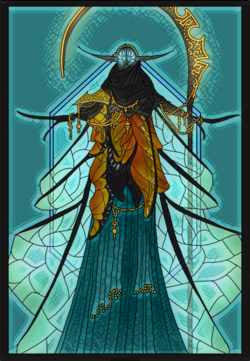
Ammuloa is the Estelley God of death and the dying. Before he joined the Estelley Pantheon, he was the patron God of nomadic Elven river tribesmen called the Loallë, who were violently conquered by Talea. It is known that he is rather fond of Cemaan, due to the fact that she inflicts much of the death which he must notate and clean up after, and they often see one another in the process of her doing so. Those who would claim Ammuloa as their patron are usually soldiers who obey his message to both face and deal death with dignity, to never deny the one they slay just burial and just afterlife, and to refrain from the cruelty of corrosive Curses and Magic when they go in for the kill.
Little icons of his hooded figure are often propped up in the corner of soldiers' chapter-houses. It is considered bad luck to depict him, though when he is it is with an insectoid form as pictured. It is equally considered bad luck to say his name when outside a place of death like cemeteries, especially in hospitals or healing houses, since inviting his attention drags the long reach of the underworld a little closer to the worshiper. Despite this, like the death Gods of most religions, Ammuloa is considered a calm, even kind figure. When a dead faithful sails down the river to the afterlife on his barge, it is him who keeps them company and comforts them.
Leyon, God of Farsight
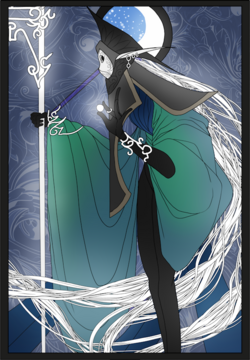
Leyon is the Estelley God of wisdom and good counsel. It is not understood when, why, or where Leyon found his way into the Estelley Pantheon, only that he mysteriously appeared and claimed a place. Talea thought that Cemaan had invited him, while Cemaan thought that Sapphora had invited him, and Sapphora thought that Talea had invited him. Leyon never speaks: he only rattles in rustling wind-chimes that the listener understands in the form of visions. He has something of a fearsome reputation among the Fae, the Demons of the Anima, and they consider him the one entity in the world that they are not willing to trifle with. As a result, he sometimes protects or saves Elves lost in the Anima. He is considered a good friend of the law Goddess Artarel, whose Godborn he shapes into existence.
In Estelley's most troubled hours, Leyon was often asked for his wisdom instead of the aggressive Cemaan. When none of them can agree, it is him who is invited to settle the dispute and make things right. His worship and patronage are somewhat complicated, because Soma already holds the domain of foresight and planning, while Cemaan holds the domain of command. To please Leyon is specifically to lead in a way that benefits and uplifts the lives of others, and to make sure that civilization works not just for you, but for them. He believes in no worshiper left behind, no friend scorned, no corruption permitted.
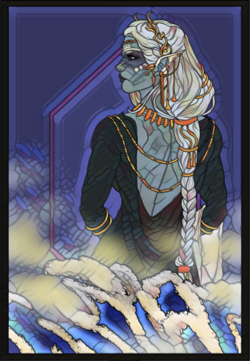
Sinnavei is the Estelley Goddess of dignity, and the patron of the Solvaan people. Before she was a member of the Estelley Pantheon, she was the patron of an Elven hill tribe called the Elari, who lived on cliffs facing the sea until Sapphora persuaded them to come and dwell in the lands below. It is well understood that she has a forbidden romance with the Evolist Demon God Morrlond, the cruel conqueror of the oceans, and that the Estelley sea Goddess who competes with him, Vyrë, does not like her because of it. After her absorption she followed the Elven colonists across the ocean who would later become the Solvaan, and adopted them as her own, appearing like one of them.
Sinnavei asks that every mortal worshiper faces the challenges of living with grace, reverence, and respect, never to betray the oaths they form, and never to falter because a promise was too dangerous. She demands that friends and allies are given dignity in wrongdoing, and enemies not mistreated beyond what is right for what they have done. She is also a symbol of Elven pro-Regalian sentiment, since at the Empire's founding she gave the signal that the Solvaan should assist, and has always exhibited pro-Unionist lip service when inquired by mortals. Sailors who wish to keep Morrlond's furious gaze away also pray to her as an intercessor.
Vyrë, Goddess of the Seas

Vyrë is the Estelley Goddess of the vast oceans and the unknown. She is immensely powerful, and the patron of the Finul culture of Elves, called an Empress by them half-jokingly in the belief that she could compete with any of the three, but merely chooses not to out of respect for their domain. In history, she fought several legendary stalemate battles with Talea, but while never subjugated was impressed by her bravery and agreed to swear fealty to her Pantheon as an equal. Vyrë asks that worshipers work together to survive the unknown that she represents, and never to falter from authority in the face of fear.
While Morrlond is fear-appeased to keep him away, sailors and especially Finul pray to Vyrë to make them glorious for her, to give them victory on the open ocean over the enemies of Elvenkind so that they can make an offering of the fallen blood to her domain. They believe that it was her who gave them their biological ability to breathe underwater, who kissed them with her touch so that they could do great deeds in her name. There is a tradition of pouring the first drink at any seafood dinner into the fire as a gift to Vyrë, to thank her for the sea's bounty.
The Outer Gods
The Outer Gods joined the Pantheon individually in the later parts of Allorn history. This was either through their subject people drifting closer to the Allorn sphere, by being outside entities that were invited, or because their previous subjects were destroyed by outside forces.
Artarel, Goddess of Just Law

Artarel is the Estelley Goddess of justice and law, a refraction of the Justice Arken. This means that she shares a set of memories with this powerful Demon, but they do not have the same beliefs or same actions, even if all awareness is shared evenly between them. The exact timeline of her manifestation into the Estelley Pantheon is unclear, because she arose as a product of mass heretical Arken Worship for Justice to deliver Elves from pain and tyranny, resulting in Artarel's divine form arising. The last gasp of any uncertainty was a few years ago, when a mass death incident caused by the Khama God Tjafar's rebirth made her play her hand openly.
Artarel demands that the worshiper is fair, honest, and even-handed, and that they hold even other Estellians accountable for their wickedness when they forget themselves and step out of line. She is a widely regarded hero-Goddess with an heirloom claymore sword called Nightfall or Maan-Menvaan, who has appeared at pivotal points in history to slay Demons, alone or in conjunction with her Arken alter ego. Artarel is responsible for a law code named after her, Artarel Law, which is the basis of all Elven Law. Its concepts include trial by jury and equality under the law, but if applied with an inflexible eye quickly become draconian.
Avinla, Goddess of Living Fire
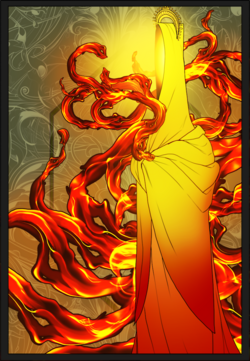
Avinla is the Estelley Goddess of family, community and warmth, and the patron of the Suvial people. A proud, independent Elven kingdom, the Suvial refused to join the Allorn Empire, and with their mastery of Demons resisted for thousands of years until finally being forced to bend the knee around a thousand years ago. With them, their Goddess Avinla finally joined the Estelley Pantheon. She is known to have been good friends with the Dragon Armina, who the Suvial held in duo-worship with her until they were converted into Estelley, and sometimes syncretize back into Draconism to retain. Avinla asks that the worshiper be inclusive, and treat their relatives and friends well, to always make sure there is a warm spot by the hearth for even the disgraced to return to.
When the Suvial became the target of Kathar mass death spells called Void-Outs in the war between them, around a hundred fifty years ago, Avinla sacrificed and petrified herself to prevent them from becoming the target of any more. With Armina disappearing around the same time, the Suvial are left without answers, and with a forced immortality that they see as a curse instead of a blessing. It is the goal of many Suvial faithful to resolve what happened to Avinla and how to bring her back, while also making sure that they will not immediately become a target again.
Melca, Goddess of All Wealth

Melca is the Estelley Goddess of all wealth, not just monetary, but also in diplomacy, allies, and true friendship from outsiders. She was once called Marxxarana, and was the duo-Goddess of a non-Elven people called the Drovv with her husband Morxxeron, a now-Dead God. When Cataclysm came three hundred years ago and Demons invaded the world, both the Drovv and Morxxeron were killed containing them, and the Elven survivors from nearby regions changed into the Sihndar. These survivors would worship the now widowed Melca, and petition Cemaan for her induction into the Pantheon, which she granted.
That Melca is a Goddess of wealth despite the Sihndar being some of the poorest people in Aloria, who live in the most miserable conditions, is seen by outsiders as an ironic consequence of her weakness. However, the Sihndar maintain a vast diplomatic network around the world and have every ear in every civilized society, squeezing out every single coin they can for the defense of their home Drowda against the endless Demons that assail it. In a kinder world, Melca would be a Goddess of coin and comfort, but her devoted Sihndar worship her because without the skill that she endears they would all die alone.
Suellon, God of Forever Change
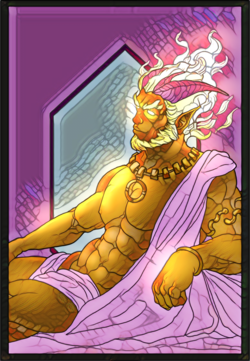
Suellon is the only Estelley God who was once a mortal man, a Teled named Suel whose life is well documented. He was a Prince with an extensive domain in central Daen, who was contracted by the Empress of the time, Vinnalea, to engineer the ultimate soldier. He experimented with Genos, the ability to alter life, until stumbling into the creation of the people who would later become the Maquixtl. Instead of giving his followers to Vinnalea to fight her wars, he betrayed her and started a large-scale insurrection instead.
When Cataclysm came, he, his spouses, and most of his followers left Daen behind and crossed the ocean to the western continent of Guldar, settling in the ruins of the dead Avarr civilization. Suellon divinely ascended by absorbing one of their Gods in unclear circumstances and making many deals with Dragons, as the now-dead Dragon Caius used to live in Guldar. After this, he smugly petitioned Cemaan to give him the chair he felt he deserved for his master ploys, which she begrudgingly accepted to claim dominion over some of the Maquixtl rather than lose then all to Draconism. Suellon tells the worshiper to be a little trickster and take advantage of even bad situations, because chaos hides opportunity for the willful.
Expanded Lore
Priesthood
An Estelley priest is called an Ordvaan, which means Guide. It is the responsibility of an Ordvaan to preach and know all the Gods. While before Cataclysm, individual teachings were decentralized, nowadays Ordvaan are answerable to something called the Presenna Council, a large conclave of Estelley priests in the Presenna Principality who rule on religious law. In places where the majority population is hostile to an Estelley minority, Ordvaan become community leaders, and in places where Magic is imperiled or outlawed, they also serve as Magic teachers. Because of the late Allorn aristocracy's large-scale corruption and deviation from Estelley virtue, many Estellians let them take this community-leader role. Estelley priests usually do not try to convert Ailor, but do try to convert Elves from the non-Estelley populations if they think they stand a chance of it working. Ordvaan can come from any Estelley cultural interpretation, like Freefolk, Teled, or Sihndar, all of whom share the same role and respect.
Historical Nuance
Over its fifteen millennia of existence, Estelley has seen turmoil and upheaval. Three hundred years ago, when the Allorn Empire was destroyed in magical calamity, it underwent a vast reform. This brought together the Gods who had drifted apart and re-formalized the religion, which at that point was in serious danger of falling apart. It is important to understand that Estelley as worshiped now is very different from Estelley as worshiped a thousand years ago, when the Allorn Empire was in free-fall decline and wracked by wars between God-like, completely unaccountable Archmages. Many of its virtues had lain forgotten, its tenets abused for violence and cruel conquest, both on other Elves and on people outside the Empire. Modern Estellians must often reckon with other faithful's historical mistrust over things that happened a very long time ago, and navigate delicately how to make it up without kneeling too low for their own tastes.
Historical Conflicts
Estelley has a long history, which contains conflicts that a learned worshiper would know about.
- Khama: At the beginning of history, the Elves revolted against the Khama Gods and their Dewamenet Empire oppressors, crushing them completely and chasing their subjects the Asha to the ends of the known world with great violence and soul-destroying magic. Cemaan killed one Khama Goddess, Pahtia, and almost killed another, her husband Khannar. The Asha do not forget, and throughout history and the modern day, are the most reliable and dedicated opponents of the Estelley religion by any means necessary. Yet, there are also whispers that the Dead Goddess Pahtia can be saved, and the old wound healed over.
- Draconism: In the late Allorn Empire, a Prince named Varendracar converted to Draconism and tried to unseat his cousin, the Empress. While Estelley doesn't specifically bless the Allorn Empire, and many Allorn atrocities are a stain on Estellians' conscience, if Varendracar won he would have dismantled Estelley as the state religion. That led to a violent reprisal that saw many Draconists murdered, even after he lost. That, and the fact that a Dragon was killed by Allorn forces (technically two, by consequences of the war), means that specifically Isldar Elves, his followers' descendants, usually have a bone to pick with Estelley.
- Evolism and Void Arken: The Dark Gods of Evolism and the Void Arken (especially Pride) played a role in ensuring the collapse of the Allorn Empire by subverting Estelley Worship and giving Elves more magical power than they knew what to do with. While the Void Arken are styled as seductive wickedness, or the idols of barbarians since the Vola Fornoss Pantheon is Void Arken and worshiped by rugged Ailor who Allorn Elves fought many wars with, the Evolist Gods are declared the ultimate evil to end all evil, and their worshipers the enemies to the death of all virtuous men.
Va'sil & Mana Trees
The Va'sil were holy nature spirits who took the form of giant, walking trees. They were holy advisors for much of Allorn history, reportedly wise, and gentle. Throughout the Allorn Empire's collapse and the decline of Estelley worship, the Va'sil and their groves became neglected. This would come to a head when the forerunners of the Kathar Heritage destroyed them in a single coordinated attack, the Night of the Fallen Star, which wiped every Va'sil tree from the world. Mana Trees, the ancient oaks at the center of Elven groves and places of worship, do still enjoy a holy status in reminiscence of the destroyed Va'sil. Yet much like the Va'sil before them, they are a target for attacks from Kathar looking to please their Gods through historical re-enactment.
Example Walking Tale
This is an example Walking Tale about the Goddess Sapphora, in case you would like to produce more scripture.
Lady Sapphora is tall and broad, clad in golden raiment and with eyes joyful as the sun.
Our Lady came down from the mountain Fyror, and found thereupon a shepherd.
He raised his crook in salute, and laid its base upon the ground, and regarded the Lady.
"Oh, Empress of Here and Now, whose Desires are manifold and occupy all things,
my neighbour has said that my staff is ugly, and that this diminishes me in the eyes of men."
Replied the Empress of Here and Now, whose Desires are manifold and occupy all things,
"Was it a staff made by the work of your own hands, which hewed and shaped the wood?
Was this artifice cut from the oaken bough by an axe which you had wielded, striking?"
Replied the shepherd, regarding his artifice of gnarled, pitted oak from an elder branch,
"It was I who hewed and shaped this wood, and made this staff by the work of my own hands."
Sapphora considered, and her pale brow knit in consideration of these worldly affairs.
"Your neighbour is jealous, for he could not shape as you have shaped. Consider:
Is it the domain of worthy men to be jealous of another? I say not, for were they worthy,
They might surpass them in artifice, and render the bounty of their labour as a gift.
Greatness falls in the grace of magnanimity, not in the abstract superiority alone."
Wondered, the shepherd bowed his head and took a knee in front of his flock, facing the Empress.
"I understand why the Empress of Here and Now is called the Empress of Here and Now,
For in the present only is graciousness found to create the work of a better future,
Which though flawed and scarred in its ways by the past as is my branch of oak roughly cut,
Will like it, last through the ages as the work of no other hands but mine."
Trivia
- Estelley worship is frequently denoted with moon symbolism, which is the heraldic icon of most Elven kingdoms.
- Talea and her arch-rival Tjafar from Khama worship are very similar: Emperor-Gods often eclipsed by their younger partner.
- The Estelley Gods' holy artifacts and tomes are scattered around the world. Not all of them have been reunited with their lost trinkets.
| ||||||||||
| Accreditation | |||||||||
|---|---|---|---|---|---|---|---|---|---|
|
| ||||||||